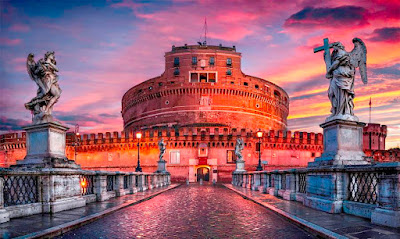 |
| Gravensteen in Belgium. |
Europe has so many castles, so here is my second part of this article of my favorite list of castles! Read part 1 here!
1. Heidelberg Castle, Germany.
Heidelberg Castle is a famous ruin in Germany and landmark of Heidelberg. The castle has only been partially rebuilt since its demolition in the 17th and 18th centuries. It is located 80 metres up the northern part of the Königstuhl hillside, and thereby dominates the view of the old downtown. The earliest castle structure was built before 1214 and later expanded into two castles circa 1294, however, in 1537, a lightning-bolt destroyed the upper castle. The present structures had been expanded by 1650, before damage by later wars and fires. In 1764, another lightning-bolt caused a fire which destroyed some rebuilt sections.
 |
| Heidelberg Castle, Germany. |
 |
| Heidelberg Castle, Germany. |
2. Bojnice Castle, Slovakia.
Bojnice Castle is a medieval castle in Bojnice, Slovakia. It is a Romantic castle with some original Gothic and Renaissance elements built in the 12th century. Bojnice Castle is one of the most visited castles in Slovakia, receiving hundreds of thousands of visitors every year and also being a popular filming stage for fantasy and fairy-tale movies.
 |
| Bojnice Castle, Slovakia. |
 |
| Bojnice Castle, Slovakia. |
3. Hohenwerfen Castle, Austria.
Hohenwerfen Castle stands high above the Austrian town of Werfen in the Salzach valley, approximately 40 km south of Salzburg. The castle is surrounded by the Berchtesgaden Alps and the adjacent Tennengebirge mountain range. The fortification is a "sister" of Hohensalzburg Castle both dated from the 11th century. Hohenwerfen Castle is situated at an height of 623 meters.
 |
| Hohenwerfen Castle, Austria. |
 |
| Hohenwerfen Castle, Austria. |
4. Bran Castle in Romania.
Bran Castle, situated near Bran and in the immediate vicinity of Braşov, is a national monument and landmark in Romania. The fortress is situated on the border between Transylvania and Wallachia. Commonly known as "Dracula's Castle", it is the home of the titular character in Bram Stoker's Dracula. The castle is now a museum open to tourists, displaying art and furniture collected by Queen Marie. Tourists can see the interior individually or by a guided tour.
 |
| Bran Castle in Romania. |
 |
| Bran Castle in Romania. |
5. Angelokastro in Corfu, Greece.
Angelokastro is a Byzantine castle on the island of Corfu, Greece. It is located at the top of the highest peak of the island's shoreline in the northwest coast near Palaiokastritsa and built on particularly precipitous and rocky terrain. It stands 1,000 ft on a steep cliff above the sea and surveys the City of Corfu and the mountains of mainland Greece to the southeast and a wide area of Corfu toward the northeast and northwest. Angelokastro is considered one of the most imposing architectural remains in the Ionian Islands
 |
| Angelokastro in Corfu, Greece. |
 |
| Angelokastro in Corfu, Greece. |
6. Prague Castle, Czech Republic.
Prague Castle is a castle complex in Prague, Czech Republic, dating from the 9th century and the official residence of the President of the Czech Republic. The castle was a seat of power for kings of Bohemia, Holy Roman emperors, and presidents of Czechoslovakia. The Bohemian Crown Jewels are kept within a hidden room inside it. It is among the largest castles in the world occupying an area of almost 70,000 m2, at about 570 meters in length and an average of about 130 meters wide.
 |
| Prague Castle, Czech Republic. |
 |
| Prague Castle, Czech Republic. |
7. Caerphilly Castle, South Wales, UK.
Caerphilly Castle is a medieval fortification in Caerphilly in South Wales. The castle was constructed by Gilbert de Clare in the 13th century. Surrounded by extensive artificial lakes, it occupies around 30 acres and is the second largest castle in Britain. In the 21st century, the Welsh heritage agency Cadw manages the site as a tourist attraction.
 |
| Caerphilly Castle, South Wales, UK. |
 |
| Caerphilly Castle, South Wales, UK. |
8. Gravensteen in Belgium.
The Gravensteen is a castle in Ghent originating from the Middle Ages. The name means "castle of the counts" in Dutch. The Gravensteen is situated at an altitude of 9 meters.
 |
| Gravensteen in Belgium. |
 |
| Gravensteen in Belgium. |
9. Trakai Island Castle, Lithuania.
Trakai Island Castle is an island castle located in Trakai, Lithuania on an island in Lake Galvė. The castle is sometimes referred to as "Little Marienburg". The construction of the stone castle was begun in the 14th century by Kęstutis, and around 1409 major works were completed by his son Vytautas the Great, who died in this castle in 1430. Trakai was one of the main centres of the Grand Duchy of Lithuania and the castle held great strategic importance.
 |
| Trakai Island Castle, Lithuania. |
 |
| Trakai Island Castle, Lithuania. |
10. Castel Sant'Angelo, Italy.
The Mausoleum of Hadrian, usually known as Castel Sant'Angelo, is a towering cylindrical building in Parco Adriano, Rome, Italy. It was initially commissioned by the Roman Emperor Hadrian as a mausoleum for himself and his family. The building was later used by the popes as a fortress and castle, and is now a museum. The Castel was once the tallest building in Rome.
 |
| Castel Sant'Angelo, Italy. |
 |
| Castel Sant'Angelo, Italy. |
I hope you liked my list and don't forget to comment your favorite!


No comments:
Post a Comment